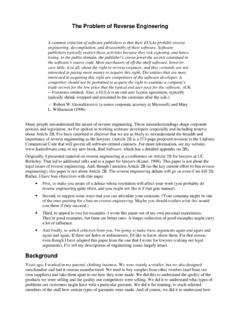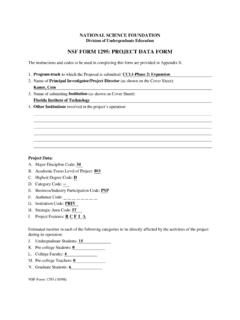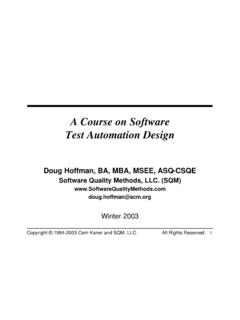Transcription of What Is a Good Test Case? - Cem Kaner
1 Good Test Cases Copyright Cem Kaner 2003. All rights reserved. Page 1 What Is a Good Test case ? Cem Kaner , , Florida Institute of Technology Department of Computer Sciences STAR East, May 2003 This research was partially supported by NSF Grant EIA-0113539 ITR/SY+PE: "Improving the Education of Software Testers." Any opinions, findings and conclusions or recommendations expressed in this material are those of the author(s) and do not necessarily reflect the views of the National Science Foundation (NSF). Abstract Designing good test cases is a complex art. The complexity comes from three sources: Test cases help us discover information. Different types of tests are more effective for different classes of information. Test cases can be good in a variety of ways. No test case will be good in all of them.
2 People tend to create test cases according to certain testing styles, such as domain testing or risk-based testing. Good domain tests are different from good risk-based tests . What s a Test case ? Let s start with the basics. What s a test case ? IEEE Standard 610 (1990) defines test case as follows: (1) A set of test inputs, execution conditions, and expected results developed for a particular objective, such as to exercise a particular program path or to verify compliance with a specific requirement. (2) (IEEE Std 829-1983) Documentation specifying inputs, predicted results, and a set of execution conditions for a test item. According to Ron Patton (2001, p. 65), Test cases are the specific inputs that you ll try and the procedures that you ll follow when you test the software.
3 Boris Beizer (1995, p. 3) defines a test as A sequence of one or more subtests executed as a sequence because the outcome and/or final state of one subtest is the input and/or initial state of the next. The word test is used to include subtests, tests proper, and test suites. Good Test Cases Copyright Cem Kaner 2003. All rights reserved. Page 2 Bob Binder (1999, p. 47) defines test case : A test case specifies the pretest state of the IUT and its environment, the test inputs or conditions, and the expected result. The expected result specifies what the IUT should produce from the test inputs. This specification includes messages generated by the IUT, exceptions, returned values, and resultant state of the IUT and its environment. Test cases may also specify initial and resulting conditions for other objects that constitute the IUT and its environment.
4 In practice, many things are referred to as test cases even though they are far from being fully documented. Brian Marick uses a related term to describe the lightly documented test case , the test idea: A test idea is a brief statement of something that should be tested. For example, if you're testing a square root function, one idea for a test would be test a number less than zero . The idea is to check if the code handles an error case . In my view, a test case is a question that you ask of the program. The point of running the test is to gain information, for example whether the program will pass or fail the test. It may or may not be specified in great procedural detail, as long as it is clear what is the idea of the test and how to apply that idea to some specific aspect (feature, for example) of the product.
5 If the documentation is an essential aspect of a test case , in your vocabulary, please substitute the term test idea for test case in everything that follows. An important implication of defining a test case as a question is that a test case must be reasonably capable of revealing information. Under this definition, the scope of test cases changes as the program gets more stable. Early in testing, when anything in the program can be broken, trying the largest legal value in a numeric input field is a sensible test. But weeks later, after the program has passed this test several times over several builds, a standalone test of this one field is no longer a test case because there is only a miniscule probability of failure. A more appropriate test case at this point might combine boundaries of ten different variables at the same time or place the boundary in the context of a long-sequence test or a scenario.
6 Also, under this definition, the metrics that report the number of test cases are meaningless. What do you do with a set of 20 single-variable tests that were interesting a few weeks ago but now should be retired or merged into a combination? Suppose you create a combination test that includes the 20 tests . Should the metric report this one test, 20 tests , or 21? What about the tests that you run only once? What about the tests that you design and implement but never run because the program design changes in ways that make these tests uninteresting? Another implication of the definition is that a test is not necessarily designed to expose a defect. The goal is information. Very often, the information sought involves defects, but not always. (I owe this insight to Marick, 1997.)
7 To assess the value of a test, we should ask how well it provides the information we re looking for. Information Objectives So what are we trying to learn or achieve when we run tests ? Here are some examples: Good Test Cases Copyright Cem Kaner 2003. All rights reserved. Page 3 Find defects. This is the classic objective of testing. A test is run in order to trigger failures that expose defects. Generally, we look for defects in all interesting parts of the product. Maximize bug count. The distinction between this and find defects is that total number of bugs is more important than coverage. We might focus narrowly, on only a few high-risk features, if this is the way to find the most bugs in the time available. Block premature product releases. This tester stops premature shipment by finding bugs so serious that no one would ship the product until they are fixed.
8 For every release-decision meeting, the tester s goal is to have new showstopper bugs. Help managers make ship / no-ship decisions. Managers are typically concerned with risk in the field. They want to know about coverage (maybe not the simplistic code coverage statistics, but some indicators of how much of the product has been addressed and how much is left), and how important the known problems are. Problems that appear significant on paper but will not lead to customer dissatisfaction are probably not relevant to the ship decision. Minimize technical support costs. Working in conjunction with a technical support or help desk group, the test team identifies the issues that lead to calls for support. These are often peripherally related to the product under test--for example, getting the product to work with a specific printer or to import data successfully from a third party database might prevent more calls than a low-frequency, data-corrupting crash.
9 Assess conformance to specification. Any claim made in the specification is checked. Program characteristics not addressed in the specification are not (as part of this objective) checked. Conform to regulations. If a regulation specifies a certain type of coverage (such as, at least one test for every claim made about the product), the test group creates the appropriate tests . If the regulation specifies a style for the specifications or other documentation, the test group probably checks the style. In general, the test group is focusing on anything covered by regulation and (in the context of this objective) nothing that is not covered by regulation. Minimize safety-related lawsuit risk. Any error that could lead to an accident or injury is of primary interest.
10 Errors that lead to loss of time or data or corrupt data, but that don t carry a risk of injury or damage to physical things are out of scope. Find safe scenarios for use of the product (find ways to get it to work, in spite of the bugs). Sometimes, all that you re looking for is one way to do a task that will consistently work--one set of instructions that someone else can follow that will reliably deliver the benefit they are supposed to lead to. In this case , the tester is not looking for bugs. He is trying out, empirically refining and documenting, a way to do a task. Assess quality. This is a tricky objective because quality is multi-dimensional. The nature of quality depends on the nature of the product. For example, a computer game that is rock solid but not entertaining is a lousy game.









